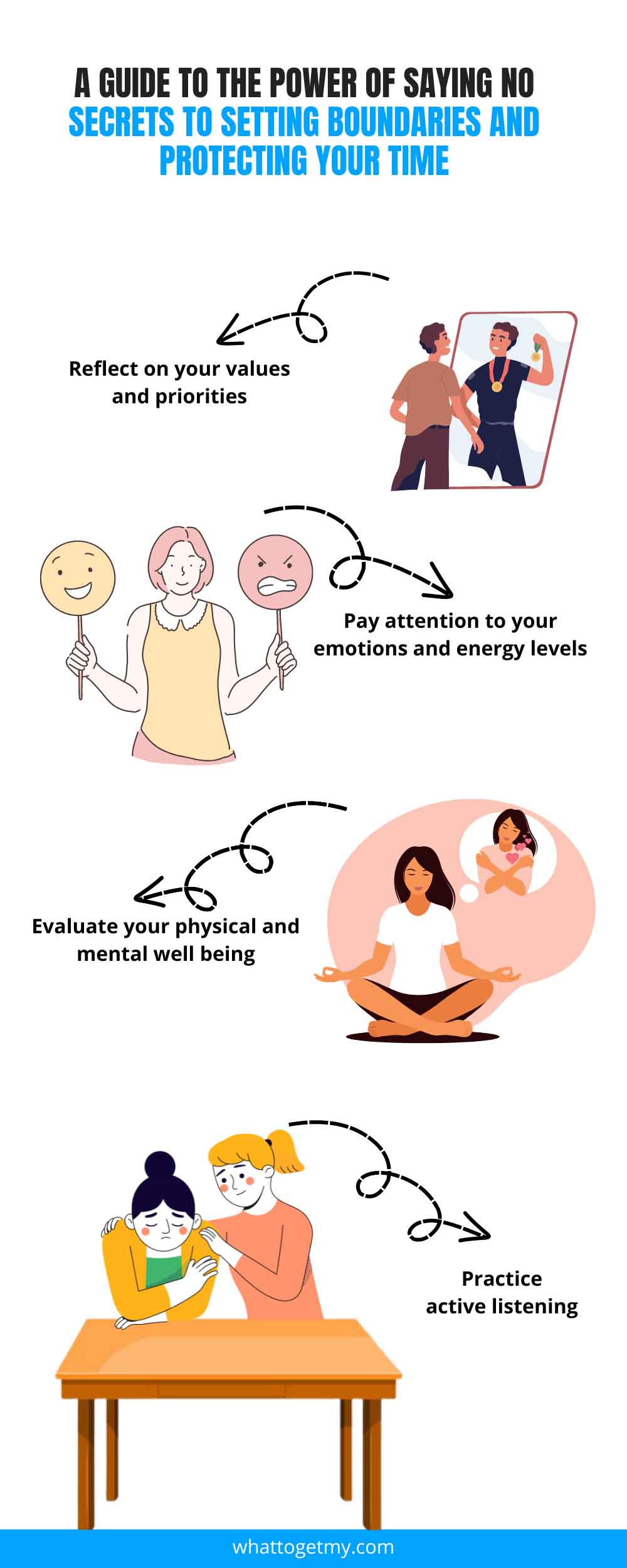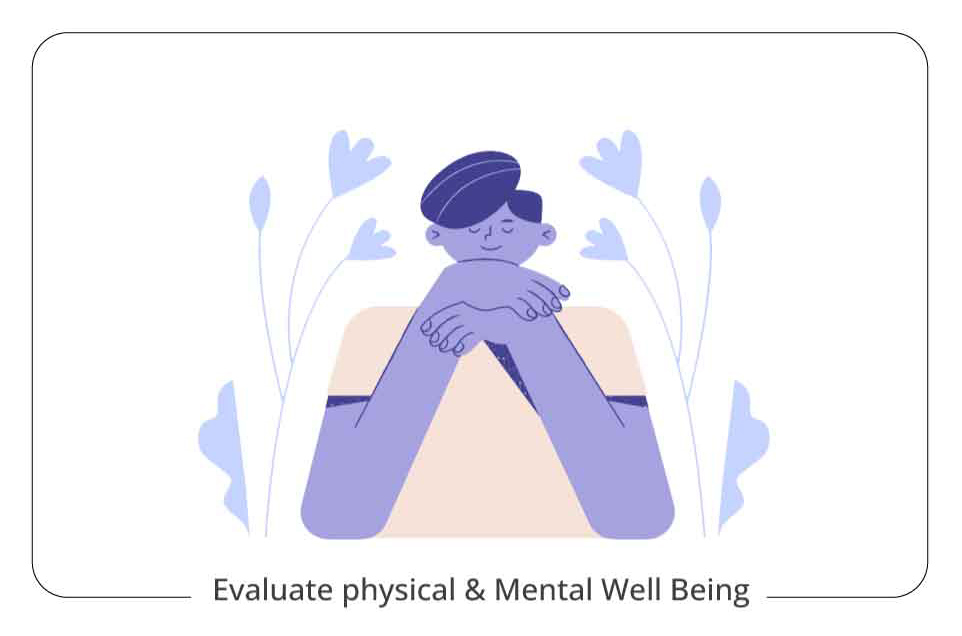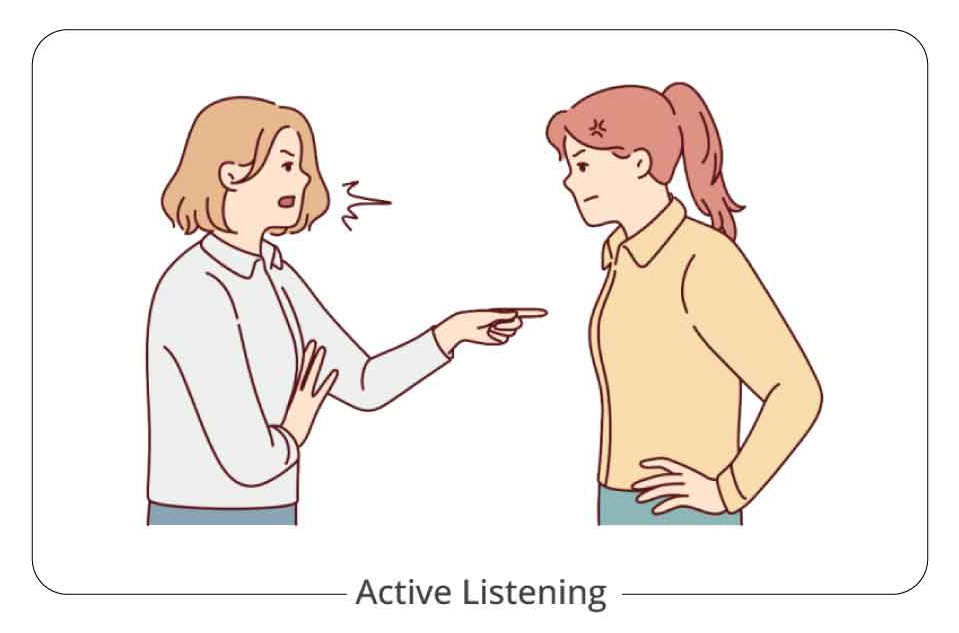A Guide to The Power of Saying No: Secrets to Setting Boundaries and Protecting Your Time in 2023
Table of Contents
Imagine a life where you have complete control over your time and confidently prioritize your needs and commitments without feeling overwhelmed.
When we fail to set boundaries in our personal and professional lives, we open ourselves up to various negative consequences.
Setting boundaries involves defining our limits and expectations for ourselves and others in various aspects of our lives.
Saying “no” can be challenging for many individuals due to various fears and concerns.
Delegation plays a vital role in maintaining boundaries and protecting your time.
I. Introduction
Imagine a life where you have complete control over your time and confidently prioritize your needs and commitments without feeling overwhelmed. Picture a world where you can say “no” when necessary, setting clear boundaries that protect your time and well-being. This is the power of saying no and setting boundaries.
In our fast-paced and demanding society, many individuals struggle with the constant pressure to say “yes” to every request and opportunity that comes their way. However, learning to say “no” and establish boundaries is essential for maintaining balance, preserving your mental and physical health, and achieving personal and professional success. This article will explore “The Power of Saying No: Setting Boundaries and Protecting Your Time.”
This article provides practical strategies and valuable insights for effectively setting boundaries and protecting your time. By learning to say no and establishing healthy limits, you can reclaim control over your life and focus on what truly matters. Whether you struggle with work-life balance, the guilt associated with declining requests, or effective communication, this article will equip you with the tools to navigate these challenges and empower you to create a life that aligns with your priorities. In today’s high-stress world, setting boundaries and saying no is essential for maintaining a healthy work-life balance and protecting our well-being.
You will embark on self-discovery and personal growth by understanding the significance of setting boundaries and saying no. So, let’s delve into the transformative power of saying no and explore the strategies enabling you to take charge of your time and protect your well-being.
II. Understanding the Importance of Setting Boundaries and Saying No
A. The negative consequences of not setting boundaries
When we fail to set boundaries in our personal and professional lives, we open ourselves up to various negative consequences. Without clear limits, our time and energy become thin, leaving us overwhelmed and burned out. We may find ourselves constantly saying “yes” to requests, obligations, and commitments that do not align with our priorities, resulting in a lack of fulfillment and a loss of control over our lives. Additionally, the absence of boundaries can lead to strained relationships, as others may take advantage of our inability to say “no.” It is crucial to recognize that failing to set boundaries ultimately undermines our well-being and hinders our ability to live a balanced and purposeful life.

B. The benefits of setting boundaries for personal well-being and productivity
On the other hand, setting boundaries can profoundly affect our well-being and productivity. By defining our limits and learning to say “no,” we create space for self-care and prioritize activities that nourish our physical, mental, and emotional health. This allows us to recharge, reduce stress levels, and maintain balance. Setting boundaries also helps us focus our energy on tasks that align with our goals and values, increasing our productivity and effectiveness. By being selective about our commitments, we can invest our time and resources in activities that truly matter, leading to greater fulfillment and accomplishment. The benefits of setting boundaries and saying no extend beyond personal well-being, as they empower individuals to take control of their time, reduce stress, and foster healthier relationships and work-life balance.
One key aspect of setting boundaries is saying “no.” Many struggle with this simple word for fear of disappointing others or the pressure to please everyone. However, saying “no” is a vital skill that allows us to protect our time, prioritize our needs, and stay true to our values. By exploring the importance of saying “no” and setting boundaries, we will uncover practical strategies to overcome the challenges associated with declining requests and learn to communicate our limits assertively. Embracing the power of saying “no” empowers us to establish healthy boundaries that safeguard our well-being and enable us to live more intentionally and more fulfilling lives.
In the following sections, we will delve deeper into the strategies and techniques for setting boundaries effectively and saying “no” with confidence. By understanding the negative consequences of not setting boundaries and the numerous benefits of doing so, we lay the foundation for reclaiming control over our time and living a more balanced and purpose-driven life.
III. Strategies for Setting Boundaries Effectively
A. The concept of setting clear and realistic boundaries
Setting boundaries involves defining our limits and expectations for ourselves and others in various aspects of our lives. Clear and realistic boundaries serve as guidelines that help us navigate our commitments, relationships, and personal well-being. It is essential to establish boundaries that are specific, measurable, attainable, relevant, and time-bound (SMART). Learning how to say no and set boundaries effectively is crucial for maintaining your well-being and managing your time and commitments. Setting clear and achievable boundaries creates a solid foundation for maintaining balance and protecting our time and energy.
B. Practical tips for identifying personal boundaries
Identifying our boundaries is a crucial step in setting them effectively. Here are some practical tips to help you identify your boundaries:
1. Reflect on your values and priorities: Consider what matters most in different areas, such as work, relationships, and personal time. This will guide you in defining boundaries that align with your core values.

2. Pay attention to your emotions and energy levels: Take note of situations or activities that drain your energy or cause emotional distress. These can indicate areas where you need to establish boundaries.
3. Evaluate your physical and mental well-being: Assess how certain situations impact your physical health and mental well-being. This awareness will help you recognize when to set boundaries to protect your wellness.
C. How to communicate boundaries assertively and respectfully
Once you have identified your boundaries, it is essential to communicate them assertively and respectfully. Here’s how:
1. Use “I” statements: Express your boundaries by using “I” statements to convey your feelings, needs, and limits. For example, say, “I need some time alone to recharge,” rather than “You are always invading my personal space.”
2. Be direct and firm: Clearly state your boundaries without ambiguity. Avoid apologizing excessively or providing lengthy explanations that may weaken your stance.
3. Practice active listening: Listen attentively and empathetically when someone challenges your boundaries or expresses disappointment. Show understanding, but remain firm in your decision.
4. Offer alternatives or compromises: Suggest alternatives or compromises that accommodate both parties’ needs while respecting your boundaries.
In addition to setting boundaries, saying “no” is a fundamental part of establishing and maintaining those boundaries. Learning to say “no” effectively is essential for protecting your time and honoring your priorities. Implementing effective strategies for setting boundaries and protecting your time is essential for maintaining productivity, reducing overwhelm, and prioritizing self-care in today’s busy world. In the upcoming sections, we will delve into strategies for setting boundaries and saying “no” with confidence. We will explore practical techniques and guide how to communicate your boundaries assertively while maintaining respectful relationships. By combining these skills, you will be equipped to create and enforce boundaries that lead to a more balanced and fulfilling life.
IV. Protecting Your Time: Establishing Healthy Work-Life Balance
A. The importance of time management and prioritization
Time management and prioritization are crucial for protecting time and establishing a healthy work-life balance. By managing your time, you can allocate resources to activities aligned with your goals and values, minimizing wasted time on non-essential tasks. Prioritization helps you identify the most critical and urgent tasks, allowing you to focus your energy on what matters. Proper time management and prioritization allow you to create space for personal and leisure activities.
A recent survey by Statista found that in West African nations, merely 60% of women possessed the autonomy to decline sexual advances. In contrast, half of the women lacked the authority to make independent choices concerning their healthcare. Sub-Saharan Africa emerges as one of the global regions where women have minimal control over their sexual and reproductive health and rights.

B. Strategies for protecting personal time and avoiding overcommitment
To protect your personal time and avoid over-commitment, consider the following strategies:
1. Learn to say “no”: Set clear boundaries and politely decline requests that do not align with your priorities. Refer to the sub-topic “The art of saying no: Establishing boundaries for work-life balance” for more guidance on saying “no” effectively.
2. Prioritize self-care: Make self-care a non-negotiable part of your routine. Schedule time for activities that rejuvenate you physically, mentally, and emotionally, such as exercise, hobbies, or simply relaxing.
3. Set realistic expectations: Be mindful of your limitations and avoid taking on more than you can handle. Assess your capacity and ensure you have enough time and energy to fulfill your commitments without compromising your well-being.
4. Delegate tasks: Identify tasks that can be effectively delegated to others, whether at work or in your personal life. Delegation not only reduces your workload but also empowers others and fosters teamwork.
C. The role of effective delegation in maintaining boundaries
Delegation plays a vital role in maintaining boundaries and protecting your time. By effectively delegating tasks, you can redistribute workload and free up time for activities aligned with priorities. When delegating, ensure you communicate your expectations, provide resources and support, and trust your capabilities. Effective delegation helps maintain boundaries and fosters collaboration and shared responsibility.
Protecting your time and setting boundaries go hand in hand when establishing a healthy work-life balance. In the upcoming sections, we will explore additional strategies and techniques to help you balance work and personal life, ensuring you have ample time for your professional responsibilities and well-being. By implementing these strategies, you can protect your time, establish healthy boundaries, and lead a more fulfilling and balanced life.
V. Overcoming Challenges: Saying No with Confidence
A. Common challenges and fears associated with saying no
Saying “no” can be challenging for many individuals due to various fears and concerns. Common challenges include the fear of disappointing others, the fear of conflict or confrontation, and the desire to be seen as helpful or accommodating. It’s essential to address these challenges and recognize that saying “no” is not selfish but rather a necessary act of self-care and boundary-setting.
B. Practical techniques for overcoming guilt and assertively saying no
To overcome guilt and assertively say “no,” consider the following techniques:
1. Reframe your mindset: Understand that saying “no” is not a hostile act but a positive step toward protecting your time, energy, and well-being. Shift your perspective and view “no” as an opportunity to say “yes” to your needs and priorities.

2. Practice self-compassion: Recognize that it is okay to prioritize yourself and set boundaries. Be kind to yourself and remind yourself that your well-being matters.
3. Use assertive communication: Clearly and confidently express your boundaries and reasons for declining a request. Use strong language, such as “I’m unable to commit to this at the moment” or “I appreciate the offer, but I need to prioritize other obligations.”
4. Offer alternatives or compromises: If appropriate, suggest alternatives that still demonstrate your willingness to support but within your boundaries. For example, offer to help later or recommend someone else who may be available.
C. The importance of self-care in maintaining boundaries
Self-care plays a crucial role in maintaining boundaries and saying “no” with confidence. It involves prioritizing activities and practices that nurture your physical, mental, and emotional well-being. Caring for yourself makes you better equipped to set and enforce boundaries. Self-care allows you to recharge, manage stress, and maintain a healthy work-life balance. By recognizing the value of self-care, you can prioritize it as an essential aspect of your life.
Overcoming guilt and practicing self-care is integral to saying “no” and setting boundaries with confidence. Recognizing the importance of self-care, saying no, and setting boundaries for personal well-being is a decisive step towards prioritizing your mental and emotional health, managing stress, and nurturing a balanced and fulfilling lifestyle. In the following sections, we will explore additional strategies and insights to help you overcome guilt, say “no” assertively, and embrace self-care to support your boundary-setting efforts. By incorporating these practices into your life, you will gain the confidence and resilience to maintain your boundaries and protect your overall well-being.
VI. Effective Communication: Assertiveness and Boundary Setting
A. The role of effective communication in setting boundaries
Effective communication lets you express your needs, limits, and expectations clearly and assertively. Communicating effectively establishes a mutual understanding with others and ensures your boundaries are respected. Effective communication fosters healthy relationships, as it promotes open dialogue and encourages respect for each other’s boundaries.
B. Strategies for assertive communication and boundary setting
To communicate assertively and set boundaries effectively, consider the following strategies:
1. Use clear and concise language: Clearly state your boundaries using simple and direct language. Avoid ambiguity or excessive explanations that may dilute your message.
2. Maintain confident body language: Stand tall, make eye contact, and use a steady tone when communicating your boundaries. Non-verbal cues can enhance the impact of your message.
3. Practice “I” statements: Express your boundaries using “I” statements to convey your feelings and needs. For example, say, “I need uninterrupted work time in the mornings” instead of, “You always disrupt my mornings.”
4. Be consistent: Consistently reinforce your boundaries to establish a clear message. Avoid sending mixed signals by consistently upholding your boundaries.
C. Active listening and empathy as tools for successful boundary establishment
Active listening and empathy are essential tools for successful boundary establishment. When setting boundaries, it is important to listen attentively to the needs and concerns of others. By actively listening, you demonstrate respect and validate their perspectives. Additionally, practicing empathy allows you to understand the impact of your boundaries on others and find mutually beneficial solutions. Incorporating active listening and empathy into your communication fosters understanding and strengthens relationships while still upholding your boundaries.

Effective communication is paramount when it comes to saying “no” and setting boundaries assertively. The sub-topic “Effective communication: Saying no and setting boundaries assertively” highlights the importance of communication skills in successfully establishing and maintaining boundaries. In the upcoming sections, we will explore additional techniques and insights to enhance your communication abilities, empowering you to express your boundaries while maintaining respectful relationships confidently. By mastering effective communication, you will have the tools to navigate difficult conversations and set boundaries supporting your overall well-being.
Ⅶ. Frequently Asked Questions:
Q1: Why is it important to set boundaries and say no?
A1: Setting boundaries and saying no is crucial for maintaining your well-being and achieving a healthy work-life balance. By setting boundaries, you establish clear guidelines for how others can treat you, ensuring your needs and limits are respected. Saying no allows you to prioritize your commitments and prevents you from overextending yourself. Both actions empower you to control your time, energy, and personal space, ultimately reducing stress, increasing productivity, and improving overall life satisfaction.
Q2: How can I overcome guilt when saying no and setting boundaries?
A2: Overcoming guilt when saying no and setting boundaries can be challenging, but it’s essential for your self-care. To overcome guilt, remind yourself that setting boundaries is not selfish but necessary for your well-being. Understand that you create space to care for yourself and fulfill your responsibilities by saying no. Practice self-compassion and recognize that you have the right to prioritize your needs. Additionally, focus on the positive outcomes of setting boundaries, such as increased productivity, improved mental health, and better relationships built on mutual respect.
Q3: How can I communicate my boundaries effectively without offending others?
A3: Communicating your boundaries is critical to maintaining healthy relationships. Here are some tips:
– Use “I” statements to express your needs and limits without blaming or criticizing others.
– Be clear and specific about your boundaries, explaining why they are essential to you.
– Practice active listening and empathy when others express their concerns or perspectives.
– Offer alternatives or compromises when possible, showing that you value the relationship and are willing to find mutually beneficial solutions.
– Remember that you cannot control how others respond, but you have the right to assert your boundaries respectfully. Respectful communication fosters understanding and opens the door for healthier dynamics in relationships.
Ⅷ. Conclusion
A. The key points discussed in the article
Throughout this article, we have explored the power of saying no and setting boundaries to protect our time and well-being. We began by understanding the importance of setting boundaries and the negative consequences of not doing so. We then provided practical strategies for setting boundaries effectively, including identifying personal boundaries and communicating them assertively. We emphasized the significance of protecting our time and establishing a healthy work-life balance through time management, prioritization, and effective delegation. Overcoming challenges and saying no with confidence was addressed, along with the role of self-care in maintaining boundaries. We also discussed the importance of effective communication, assertiveness, active listening, and empathy in boundary setting.
B. The importance of setting boundaries and saying no
Setting boundaries and saying no is essential for our well-being, productivity, and overall quality of life. Establishing clear boundaries protects our time, energy, and mental health. Saying no allows us to prioritize our needs and commitments, enabling us to lead a more balanced and fulfilling life. It is essential to recognize that setting boundaries and saying no are not selfish acts but rather acts of self-care and self-respect.
C. Implement the strategies provided
Now that you have gained insights and practical strategies for setting boundaries and saying no, it is time to implement them. Take the knowledge you have acquired and start implementing these strategies in your daily life. Remember that boundary-setting is a continuous process that requires practice and self-awareness. Be patient with yourself as you navigate this journey, and remember that it is okay to adjust and refine your boundaries as needed.
D. Call to action
In conclusion, setting boundaries and saying no are powerful tools that allow us to protect our time, establish a healthy work-life balance, and prioritize our well-being. Embrace the power of saying no and setting boundaries confidently, knowing that it is essential to creating a life that aligns with your values and priorities. Take control of your time and make space for what truly matters. It’s time to reclaim your time and protect your boundaries. Start today and experience the positive impact it can have on your life.
Remember, you have the power to say no and set boundaries. It’s time to embrace that power and create a life that reflects your true priorities.
02 HOURS 41 MINUTES
ESTIMATED TIME DESIGNING AND UPLOADING THIS ARTICLE
08 HOURS 31 MINUTES
ESTIMATED TIME RESEARCHING AND WRITING THIS ARTICLE
LOOKING FOR MORE GIFTS?
Try our AMAZING GIFT FINDER TOOL! Find GIFTS with 1 CLICK!
LOOKING FOR MORE GIFTS?
Try our AMAZING GIFT FINDER TOOL! Find GIFTS with 1 CLICK!
LOOKING FOR MORE GIFTS?
Try our AMAZING GIFT FINDER TOOL! Find GIFTS with 1 CLICK!
You Might Also Like

11 Signs that Alcohol Is Killing You
11 Signs that Alcohol Is Killing You WhatToGetMy Instructional Article Every year it is estimated that alcohol contributes to the deaths of over 3 million people with men being more affected than women. Whilst some of this death is instantaneous such as with car accidents

EXPENSIVE GIFTS FOR BOYFRIEND’S BIRTHDAY
Is your boyfriend celebrating his birthday soon? And you are looking to do something special this year, maybe to surprise him with a great, expensive gift to show him how much you love him? If so, you have come to the right palace! We have

11 EXPERT ADVICE: WHY DOES MY DAUGHTER WANT TO GET MARRIED?
11 EXPERT ADVICE WHY DOES MY DAUGHTER WANT TO GET MARRIED WhatToGetMy Instructional Article Make sure your daughter knows you’ll still be there for her whether she’s leaving home to create a new family or not. Despite being young, she is confident in herself. Some

19 Roomie Gifts For New Roommates
Welcome your roommate with the new roommate welcome gifts we have listed to establish a connection with your new roommate. These are small, yet thoughtful gifts that are sure to put them at ease and warm them up to you. Also give them gifts on

19 Fun Father’s Day Gifts for Gamers
You can make Father’s day exciting for a gamer dad by getting him gifts that will add to his gaming experience. In this article, we’ve identified 19 gifts to get a gamer dad this father’s day but before we dive right into it, be sure

14 Signs Your Friend Doesn’t Care about You
A friend is someone who always stands by you through thick or thin, but if you noticed that your friend is showing an “I don’t care attitude,” it will be best for you to look out for signs your friends doesn’t care about you. This

7 Legal Things to Do After Getting Married
7 Legal Things to Do After Getting Married WhatToGetMy Instructional Article It is nothing short of thrilling to be in a union with your long-term partner. However, marriage comes with several legal obligations. Discover and learn seven legal things to do after getting married. Marriage

Secret Santa Gift Ideas for Managers
Being a secret Santa is sometimes really stressful. Nobody will know what you got, that’s true, but you will! How are you supposed to live with yourself knowing that you gave a wrong gift to somebody? As if things couldn’t be any worse, you pulled

7 Tips on how to be Flirty on Tinder
7 Tips on how to be Flirty on Tinder WhatToGetMy Instructional Article Thousands of people every day find love online. Everyone has their way of flirting through online messages. If you struggle to flirt on Tinder, you may need some flirting lessons. Tinder is like

Why Doesn’t My Husband Listen To Me? – 11 Reasons Your Husband Might Not Listen To You
Time taken : 11 hours 42 minutes An ideal marriage is one where both spouses can communicate effectively. In such a marriage, both spouses not only have the freedom to voice their opinions but can listen to what the other has to say. Sadly, communication



